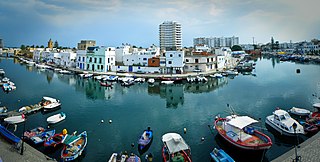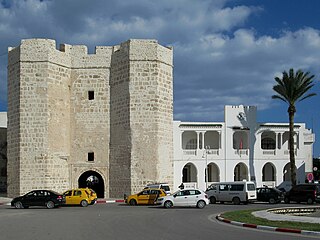Related Research Articles

Tunisia, officially the Republic of Tunisia, is the northernmost country in Africa. It is a part of the Maghreb region of North Africa, bordered by Algeria to the west and southwest, Libya to the southeast, and the Mediterranean Sea to the north and east. It features the archaeological sites of Carthage dating back to the 9th century BC, as well as the Great Mosque of Kairouan. Known for its ancient architecture, souks and blue coasts, it covers 163,610 km2 (63,170 sq mi), and has a population of 12.1 million. It contains the eastern end of the Atlas Mountains and the northern reaches of the Sahara desert; much of its remaining territory is arable land. Its 1,300 km (810 mi) of coastline include the African conjunction of the western and eastern parts of the Mediterranean Basin. Tunisia is home to Africa's northernmost point, Cape Angela; and its capital and largest city is Tunis, which is located on its northeastern coast, and lends the country its name.

Tunis is the capital and largest city of Tunisia. The greater metropolitan area of Tunis, often referred to as "Grand Tunis", has about 2,700,000 inhabitants. As of 2020, it is the third-largest city in the Maghreb region and the eleventh-largest in the Arab world.

Tunis–Carthage International Airport, is the international airport of Tunis, the capital of Tunisia. It serves as the home base for Tunisair, Tunisair Express, Nouvelair Tunisia, and Tunisavia. The airport is named for the historic city of Carthage, located just east of the airport.

Bizerte or Bizerta the classical Hippo, is a city of Bizerte Governorate in Tunisia. It is the northernmost city in Africa, located 65 km (40mil) north of the capital Tunis. It is also known as the last town to remain under French control after the rest of the country won its independence from France. The city had 142,966 inhabitants in 2014.

Gabès, also spelled Cabès, Cabes, Kabes, Gabbs and Gaps, is the capital city of the Gabès Governorate in Tunisia. It is located on the coast of the Gulf of Gabès. With a population of 152,921, Gabès is the 6th largest Tunisian city. Gabes is 327 km away from Tunis and 113 km away from Sfax.

Mahdia is a Tunisian coastal city with 62,189 inhabitants, south of Monastir and southeast of Sousse.

The Tunis-Goulette-Marsa or TGM is a 19 km (12 mi) 1,435 mm commuter rail line in Tunisia. It links the capital city, Tunis, with the town of La Marsa via La Goulette.

Sfax is a city in Tunisia, located 270 km (170 mi) southeast of Tunis. The city, founded in AD 849 on the ruins of Berber Taparura, is the capital of the Sfax Governorate, and a Mediterranean port. Sfax has a population of 330,440. The main industries are phosphate, olive and nut processing, fishing and international trade. The city is the second-most populous in the country after the capital, Tunis.
Sidi Bouzid, sometimes called Sidi Bou Zid or Sīdī Bū Zayd, is a city in Tunisia and is the capital of Sidi Bouzid Governorate in the centre of the country. Following the suicide of Mohamed Bouazizi in Sidi Bouzid, it was the site of the first clashes of the Tunisian Revolution and a catalyst for other protests in the region, often known as the Arab Spring.

Siliana is a modern farming town in northern Tunisia. It is located at around 36°4′55″N9°22′29″E, 130 km south-west of the capital Tunis. It is the capital of the Siliana Governorate. It is located 4 miles away from Jama where the Battle of Zama occurred.

La Marsa La Marsa is a coastal city located in the northeastern part of Tunisia, situated along the Mediterranean Sea. It is part of the Tunis Governorate and has a population of around 100,000 people. The city is known for its beautiful beaches, upscale residential areas, and lively atmosphere, with numerous restaurants, cafes, and shops.It is connected to Tunis by the TGM railway. Gammarth is adjacent to El Marsa further up the coast.

Stade Tunisien or ST is a football club from Bardo, Tunis, Tunisia. Alongside Espérance de Tunis and Club Africain it forms the group of three best teams in the capital city region. Founded in 1948, it is the successor of the football section of the defunct Association of Young Muslims of Bardo founded in 1923. The team plays in green, red and white colours, after the Bey colours, as the team was under their patronage until the Tunisian independence. Their ground is Hedi Ennaifer, which has a capacity of 12,000.

The Société Nationale des Chemins de Fer Tunisiens, abbreviated SNCFT, is the national railway of Tunisia and under the direction of the Ministry of Transport. SNCFT was founded on December 27, 1956 It Replaced the Tunisian Railway Farms Company (CFT). Headquartered in Tunis the company employs about 6000 people. SNCFT provides both passenger and freight services at a national level.

Rail Transport in Tunisia is provided by:

Tourism in Tunisia is an industry that generates around 9.4 million arrivals per year in 2016, 2017, 2018, 2019 & 2020, which makes it one of the most visited countries in Africa. Tunisia has been an attractive destination for tourists since the beginning of the 1960s.

Railway stations in Nigeria include:

In Tunisian football, the Tunis derby is the local derby between the two major clubs in the city of Tunis, Tunisia – Club Africain and Espérance de Tunis. The derby is played in Tunis in the Hammadi Agrebi stadium due to its larger capacity of 60,000 seats. Before the construction of this stadium, the derby used to be played in the 45,000 seat-capacity Stade El Menzah.
Railway stations in Tunisia include: (stations grouped by lines)
The following is a timeline of the history of the city of Tunis, Tunisia.

Urban rail transit in Africa has emerged as a growing form of transit due to rapid urbanization that has occurred in recent decades across the continent. Some of these transit systems are older and more developed, such as the metro in Cairo which opened in 1987. Others such as the light-rail system in Addis Ababa are much more recent, which opened in 2015. A variety of technologies are being used ranging from light-rail, bus rapid-transit, and commuter-rail etc. Africa for several decades saw minimal investment in rail infrastructure, but in recent years due to urban population growth and improved financing options, investment in rail networks has increased.
References
- ↑ "Tunisia - Africa - Forums - Railpage - Railpage Australia". Railpage. Retrieved 2012-11-08.
- ↑ "New Trains in Tunisia Promise Faster and More Efficient Commutes". Tunisia Live. Retrieved 2012-11-08.